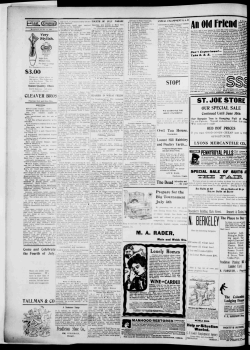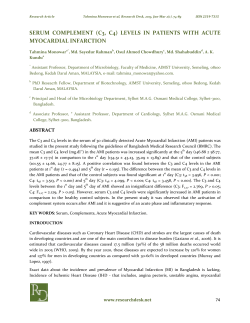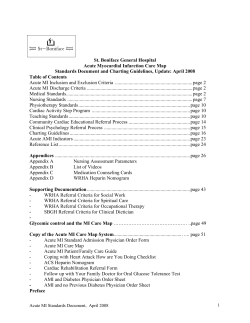
Improved Care for Acute Myocardial Infarction The Key Components of Reliable,
Spring 2007 Improved Care for Acute Myocardial Infarction The Key Components of Reliable, Evidence-Based AMI Care By Cleo Cyr RN, BN, MHS, CCN (C) Safer Healthcare Now! is a campaign designed to enlist Canadian healthcare organizations to implement targeted evidence based interventions in patient care. The campaign is supported by the Institute for Healthcare Improvement (IHI) and is patterned after IHI’s 100,000 Lives Campaign. Cardiovascular diseases (CVD) are the primary cause of death in Canada. Approximately one-third of the several million people in Canada and the United States diagnosed with acute myocardial infarction (AMI) die during the acute phase. It is for this reason that one of the Safer Health Care Now! goals is to prevent deaths among patients hospitalized for AMI by ensuring reliable delivery of evidence based care1. To accomplish this task the American College of Cardiology (ACC), the American Heart Association (AHA), the Canadian Cardiovascular Society and the Canadian Cardiovascular Outcomes Research Team (CCORT) have worked with clinicians to develop guidelines for care based on evidence and to promote awareness of evidencedbased care in the clinical community. Efforts have also been made to educate the general public and emergency responders about the symptoms of AMI and the need for immediate treatment1. Studies have shown that patients with AMI should receive specified components of care in order to reduce morbidity and mortality. The total number and type of care components a patient receives during the hospital course and post-discharge may vary based on clinical condition and other co-morbidities. However, there is strong evidence in the literature to support that the following seven key care components should be provided to all AMI patients except where contraindicated: 1. Early administration of aspirin 2. Aspirin at discharge 3. Beta-blocker at discharge 4. Timely initiation of reperfusion (thrombolysis or percutaneous intervention) 5. ACE-inhibitor or angiotensin receptor blockers (ARB) at discharge for patients with systolic dysfunction 6. Smoking cessation intervention (counseling / nicotine replacement / serotonin uptake inhibitor / referral to cardiac rehabilitation program) 7. Statins at discharge Documentation that each component of care was provided or contraindicated should be in the medical record for each AMI patient. These are “process measures”. Improvement in an individual measure indicates that the processes surrounding that care element have improved. However, if it is identified that care components are not at a predetermined goal level, a change in practice is necessary and improvement strategies need to be developed. The Saint John Regional Hospital (SJRH) Experience In September of 2005, following corporate and quality risk management leadership from the Atlantic Health Sciences Corporation (AHSC), a multidisplinary team of health care professionals under the direct leadership of the NB Heart Centre (NBHC) was established. The team’s mandate was to develop a strategy that identified current practice while simultaneously developing a Safer Health Care Now! (SHN) Improvement Charter based on four key concepts: 1. What are we trying to accomplish? 2. How will we know a change is an improvement? 3. What changes can we make that will result in an improvement? 4. How will we manage the improvement project? The project was divided into three phases. Phase 1 included performing a retrospective chart audit to determine baseline AMI care at the SJRH. The second phase identified change concepts that could be tested using an evidenced based Improvement Model and fine- tuning the Improvement Charter based on the baseline data. Phase 3 was designed to identify opportunities to spread the project to other care areas. Some overlap has occurred across the phases. Retrospective Baseline Analysis 4. Lack of evidence that smoking cessation interventions were initiated unless referral to cardiac rehabilitation programs had occurred. 5. Lack of availability of Nicotine Replacement Therapy through the hospital formulary. 6. Although 40% of patients arrived by ambulance to the ED, 60% of patients arrived by other means. 7. The average time from arrival to physician Identifying change concepts requires knowing assessment for patients with ST elevation where to begin. A retrospective analysis of AMI patients myocardial infarctions (STEMI) was 12 minutes. admitted through the emergency department at the SJRH 8. Although 40 % of ECG’s in the ED were signed by from September 2004 to June 2005 was performed and a physician, 60% were not. provided baseline data for analysis of the components for AMI care. Other data collected for information purposes Using the Model for included the number Improvement of appropriate patients Table 1: Retrospective Baseline Results: Four areas of prescribed lipid-lowering 10 month period from Sept 2004 – June 2005 (n=95) improvement were therapy on discharge and AMI Indicators Goals (SJRH) Results identified following the number of patients ASA at Arrival 90% 100% analysis of the baseline referred to cardiac data. ASA at Discharge 90% 100% rehabilitation. It should Beta Blocker at Discharge 90% 97.6% 1) Improve ‘door to be noted that prescribing thrombolysis time’ statins at discharge was Thrombolytic Agent within 30 minutes 85% *72.4% (optimally less than 30 added as a seventh PCI within 90 minutes 90% *77.8% minutes). care component in April ACE/ARB on Discharge (EF <40%) 85% 86.9% 2007. Care components 2) Improve ‘door to PCI Adult Cigarette Smoking Cessation that did not meet SHN 100% *78.7% time’ (optimally less Advice goals included timely than 90 minutes). Perfect Care 95% *74.5% initiation of reperfusion 3) Improve smoking Other data collected (thrombolysis and cessation percutaneous coronary Cardiac Rehab Referrals **NA 60% interventions for intervention [PCI]), **NA identified smokers. smoking cessation Lipid Lowering Med on discharge Until April 86.5% 4) Improve intervention, and perfect 2007 documentation for all care (percentage of * Components of care not at Safer Health Care Now! goals on the elements. Retrospective Baseline Analysis. ** Not applicable patients that received all care components, if not Safer Health Care contraindicated) (Table 1). Now! strategists have adopted a Model for Improvement Key Factors Identified called the Plan-Do-Study-Act (PDSA) Cycle (Figure 1). Performing the chart audit and retrospective analysis Developed by Associates in Process Improvement, this helped identify key factors from which the Improvement model is a simple yet powerful tool for accelerating Charter could be further defined. These included: improvement that has been used successfully by hundreds of health care organizations to improve many different 1. Lack of ‘easy to find’ documentation of all care health care processes and outcomes. The model has two components. parts. The first is designed to set clear aims; establish 2. Documentation discrepancies between the measures that will tell exact times if changes are leading electrocardiograms to improvement; and (ECG) were identify changes that performed, are likely to lead to physicians were improvement. The notified and second part is designed treatment initiated to conduct small-scale in the emergency tests of change in real department (ED). work settings. This 3. Unclear reasons is accomplished by why patients may identifying a change or may not have then implementing Planbeen discharged Do-Study-Act (PDSA) on certain types of cycles. After testing a medications (i.e. change on a small scale, beta blockers and learning from each test, ACE inhibitors). and refining the change through several PDSA NB Heart Centre HeartBeat • Spring 2007 2 cycles, the team can implement the change on a broader scale. This scientific method is used for action-oriented learning. the key factor for improvement. Small March to October 2006 (n-128) changes such as SJRH improvement in Retrospective the time patients Full Baseline Results AMI Indicators Goals Implementation received the first 10 month period Results ECG (Figure 2) and from Sept 2004 – June 2005 (n=95) time to physician A challenge assessment for ASA at Arrival 90% 100% 96% at the SJRH was STEMI patients ASA at Discharge 90% 100% 100% to coordinate an (Figure 3) in the ED action plan between Beta Blocker at Discharge 90% 97.6% 96.5% helped improve the emergency Thrombolytic Agent within 30 outcomes. The 85% *72.4% 93.6% department, minutes significant increase interventional PCI within 90 minutes 90% *77.8% 100% in the number of cardiology, the ACE/ARB on Discharge (EF <40%) 85% 86.9% 100% signed ECG’s in coronary care unit the ED (Figure 4) Adult Cigarette Smoking and the coronary 100% *78.7% 92% was evidence of Cessation Advice stepdown unit. increased awareness Perfect Care 95% *74.5% 92% Raising awareness and accountability. Other data collected was the first PDSA To recognize cycle established Cardiac Rehab Referrals **NA 60% 80% and celebrate with presentation NA Until the successes of of the baseline data Lipid Lowering Med on discharge April 86.5% 97.5% improved outcomes, made to multiple 2007 run charts were stakeholders in Clopidogrel on discharge when posted in each **NA Not Assessed 100% all areas involved. indicated of the clinical Simultaneously, a * Components of care not at Safer Health Care Now! goals on Retrospective Baseline Analysis. areas involved data collection form ** Not applicable and results shared that included the at department seven components meetings. A “Believe & Succeed” slogan was adapted as of care was developed (Appendix A). This AMI a motivational tool with posters displayed in key care areas documentation tool was also designed to collect data for (Appendix B). Acute Coronary Syndrome (ACS) patients as the care Spinoffs: Figure 2: STEMI: Time to 1st ECG in Minutes team felt it was necessary Opportunities for March - October 2006 (Avg 5.3 min n=55) to analyze care across this population as well. The Improvement form was designed to be There have been completed by health care significant opportunities professionals in each care for improvement in area from the patient’s unexpected areas arrival in the ED to the through the process of cardiac catheterization implementing the AMI lab if indicated, to the improvement model of coronary care unit and care. A committee has finally for completion in been established to the coronary stepdown discuss the feasibility unit at time of discharge. of paramedics initiating The inclusion of the electrocardiograms question”If not, why not?” in ambulances with the intention of early provision of in the discharge medication section was designed as a thrombolysis supported by emergency department specific intervention to improve documentation. physicians. As well, referral to cardiac rehabilitation Multiple small PDSA cycles performed from March programs has increased by 20% and discharge teaching to May 2006 involved using, analyzing and finalizing the practices have improved. documentation form resulting in full implementation of A Tobacco Reduction Strategy for patients has been this useful tool in June 2006. Improvement has been seen developed and spread region wide. The strategy has in components of care (Table 2) with reperfusion times for involved the hospital formulary inclusion of nicotine STEMI patients increased by 22% for both thrombolysis replacement therapy for inpatients and implementation of and PCI interventions and 11% for lipid lowering therapy a Clinical Tobacco Intervention “Train the Trainer” program across all populations. As well, for patients who use a that addresses the issue of every inpatient and outpatient tobacco product, smoking cessation interventions have being offered assistance through an “Ask, Advise and increased by 13%. Documentation has become a succinct Assist” program. Cessation materials can be ordered process with usage of the data collection form. Raising through a central repository located in the health regions’ awareness of baseline versus concurrent practice was Table 2: Full Implementation Results NB Heart Centre HeartBeat • Spring 2007 3 Health Sciences Library at the SJRH for dissemination within the region. Through this one example a culture of awareness has helped move the SHN campaign to a level where impact is increased by spreading interventions across patient populations, not only to those requiring AMI care. Other issues have included a closer evaluation of clopidogrel usage, development of a patient discharge tool that incorporates SHN care components, and improved communication and documentation. process with effective leadership skills (Figure 5)1. Figure 3: Time to Charted Physician Assessment (ED) in minutes for STEMI Patients. March - October 2006 (Avg 7.4 min n=55) 5. Use the Improvement Model to find out what works – SMALL TESTS of CHANGE. 6. Communicate widely your learning. 7. Spread proven changes and change principles to other areas seeking input from those involved, especially those affected by the change. Show appreciation for their efforts. 8. Build on your successes! Figure 4: Percentage of STEMI ECG’s signed by physicians in ED March - October 2006 (n=55) Atlantic and National Support Other Spread Opportunities The goal of having at least 90% of AMI patients receive identified care components has been accomplished. A three- pronged process to spread the initiative further includes implementing the documentation tool in another SJRH intensive care unit that receives a small number of AMI patients, as well as to three other hospital facilities in the region. Efforts are ongoing to continue to foster collaborative relationships with other hospitals in New Brunswick currently involved in SHN processes. The goal is to work together to improve linkages that ultimately support improved patient care. Creating a Culture for Change and Quality Improvement Successful improvement in AMI care cannot occur without dedicated teams and defined steps for quality improvement. The following eight steps for improvement, as defined by SHN, have helped shape the success of this campaign at the SJRH. These steps include: 1. Know your system by mapping it out while recognizing and respecting the busy health care environment in which health care professionals work. 2. Collect baseline data to identify areas for improvement. 3. Improve leadership awareness and approval by using data for support. Much has been accomplished since the SHN campaign was launched in 2005 and a ‘chord of caring’ has been struck across Canada. With its goal to improve healthcare delivery by focusing on patients and their safety while in the care of health care providers, SHN teams have evoked a collaborative effort that has proven to be successful. Part of that success involves the creation of a supportive infrastructure that includes four groups of people distributed across Canada within Western, Ontario, Quebec and Atlantic Nodes. The purpose of each node is to: • • • Raise awareness of the SHN Campaign. • • Share Campaign updates. Facilitate and promote enrollment. Facilitate and provide educational opportunities for Campaign participants related to interventions, measurement, and quality improvement. Coordinate and provide intervention-related clinical, quality improvement and measurement assistance. • Facilitate communication between and among: teams, nodes, working groups, clinical supports, Figure 5: Ingredients to Build an Effective Team partners, funders, the Node Steering Committee and the National Steering Committee1. 4. Form a multidisciplinary team – people involved in the day-to-day NB Heart Centre HeartBeat • Spring 2007 Atlantic Node leader Theresa Fillatre, and Safety and Improvement Advisor Dannie Currie, have been instrumental in moving the campaign forward in Atlantic 4 Canada. As data is collected it is forwarded by secure the SJRH. Additional benefits have been an increase in website to the University of Toronto where the Central the administration of lipid lowering therapy, referral to Measurement Team cardiac rehabilitation under the direction of programs and improved Figure 6: Quarterly Reports: Virginia Flintoft provides access times to ECGs SJRH Run Chart for Thrombolytic Care analysis. Quarterly and physician assessment reports are forwarded to in the emergency teams involved in SHN department. Spinoffs have improvement projects resulted in discussion that that help teams evaluate will potentially lead to progress in relation to earlier delivery of care by other groups regionally paramedics and a tobacco and nationally (Figure 6). reduction strategy that The process of ongoing has spread throughout the support and feedback is Atlantic Health Sciences therefore evident locally, Corporation area of care provincially, regionally delivery. NB Heart Centre and nationally. SHN is strategies for spreading a grassroots campaign the SHN campaign designed to link multiple include enhancing local, levels of people involved regional and provincial in patient care – to the partnerships. The success benefit of all! of the campaign and improved patient care are best described by the simple fact that better outcomes can be Summary achieved in small steps designed to happen over time. As a result, patients benefit from both Safer Health Care and Implementing SHN has resulted in improvement in improved outcomes. reperfusion care and smoking cessation interventions at References 1. Safer Health Care Now! Website: www.saferhealthcarenow.ca NB Heart Centre HeartBeat • Spring 2007 5 Appendix A NB Heart Centre HeartBeat • Spring 2007 6 NB Heart Centre HeartBeat • Spring 2007 7 Appendix B www.saferhealthcarenow.ca Believe & Succeed! Improving AMI Care Together Collaborative Team: SJRH Emergency Dept • Emergency Medical Services • Quality Risk Management NB Heart Centre • Cardiac Rehab • Cardiac Cath Lab • CCU/SDU • Cardiac Surgery ICU • Electrodiagnostics Dept • Physicians • Nurse Clinicians • Nurse Associates
© Copyright 2025





















